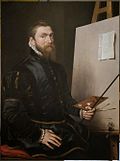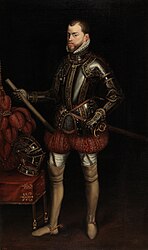File:Felipe II, con la armadura de San Quintín.jpg

Original file (1,136 × 1,920 pixels, file size: 1.42 MB, MIME type: image/jpeg)
Captions
Captions
Summary[edit]
| anonymous: Philip II in St. Quentin's Armour
|
|||||||||||||||||||||||||
|---|---|---|---|---|---|---|---|---|---|---|---|---|---|---|---|---|---|---|---|---|---|---|---|---|---|
| Artist |
artist QS:P170,Q4233718,P1877,Q176694 |
||||||||||||||||||||||||
| Title | |||||||||||||||||||||||||
| Object type |
painting |
||||||||||||||||||||||||
| Genre |
portrait |
||||||||||||||||||||||||
| Description |
Español: A lo largo del siglo XVI y buena parte del XVII los retratos de la familia Habsburgo fueron ampliamente divulgados a través de numerosas versiones y copias realizadas por artistas de calidad muy diversa, dependiendo de circunstancias y contextos también distintos. Atendiendo al prestigio de sus reinados y a la eficacia visual de los retratos elaborados bajo sus respectivos gobiernos, fueron las efigies de Carlos V y Felipe II las más repetidas durante ese periodo. Este retrato del Rey fue precisamente pensado para emparejarse con el retrato del Emperador (P6082), copia de la tela pintada por Juan Pantoja de la Cruz en 1605 a partir de un original [hoy perdido] de Tiziano. La estrecha relación entre ambos retratos explica las características específicas de esta composición, que deriva básicamente del retrato de cuerpo entero pintado por Antonio Moro en 1560 para celebrar la victoria frente a los franceses en San Quintín. En este, Felipe II aparece desafiante, fuertemente iluminado, surgiendo de un fondo oscuro y cubierto con el peto del arnés de aspas. Este ejemplar debió de ser modelo para esta versión del Prado, así nos lo indican ciertos detalles del rostro y la tonalidad carmesí adoptada para los gregüescos. No obstante, hay variantes muy notables; la disposición del monarca está invertida con respecto al original, debido sin duda a su relación con el retrato de Carlos V. Además se han incluido más piezas de la célebre armadura, tanto las que completan los brazos (hombrera, codal, brazal) y las manoplas, como la de la cabeza, la magnífica celada que descansa sobre un bufete próximo. Tanto el retrato de Carlos V como éste de Felipe II fueron pintados por un artista correcto y conciso en la repetición de los rostros, que al tiempo transmitió con absoluta fidelidad las piezas de la armadura. Este hecho es el más significativo de la obra, y hace suponer que en el encargo de los dos retratos se pretendió precisamente subrayar el prestigio de esos valiosos atavíos militares. |
||||||||||||||||||||||||
| Depicted people |
Philip II of Spain |
||||||||||||||||||||||||
| Date |
between 1601 and 1650 date QS:P,+1650-00-00T00:00:00Z/7,P1319,+1601-00-00T00:00:00Z/9,P1326,+1650-00-00T00:00:00Z/9 |
||||||||||||||||||||||||
| Medium |
oil on canvas |
||||||||||||||||||||||||
| Dimensions |
height: 207 cm (81.4 in) dimensions QS:P2048,+207U174728 dimensions QS:P2049,+123U174728 |
||||||||||||||||||||||||
| Collection |
institution QS:P195,Q160112
|
||||||||||||||||||||||||
| Current location |
institution QS:P195,Q38227904 |
||||||||||||||||||||||||
| Accession number |
P006083 (Museo del Prado) |
||||||||||||||||||||||||
| Notes | Serie: Proyecto de Sala de Retratos de los Reyes de la Casa de Austria y Borbón, Real Museo; Procedencia: Colección Real (Casa del Nuevo Rezado, Madrid, 1847). | ||||||||||||||||||||||||
| References | |||||||||||||||||||||||||
| Source/Photographer | Museo del Prado. | ||||||||||||||||||||||||
Licensing[edit]
|
This is a faithful photographic reproduction of a two-dimensional, public domain work of art. The work of art itself is in the public domain for the following reason:
The official position taken by the Wikimedia Foundation is that "faithful reproductions of two-dimensional public domain works of art are public domain".
This photographic reproduction is therefore also considered to be in the public domain in the United States. In other jurisdictions, re-use of this content may be restricted; see Reuse of PD-Art photographs for details. | |||||
File history
Click on a date/time to view the file as it appeared at that time.
| Date/Time | Thumbnail | Dimensions | User | Comment | |
|---|---|---|---|---|---|
| current | 14:22, 9 June 2018 |  | 1,136 × 1,920 (1.42 MB) | FDRMRZUSA (talk | contribs) | User created page with UploadWizard |
You cannot overwrite this file.
File usage on Commons
The following 2 pages use this file:
File usage on other wikis
The following other wikis use this file:
- Usage on es.wikipedia.org
- Usage on it.wikipedia.org
- Usage on uk.wikipedia.org
- Usage on www.wikidata.org
- Wikidata:WikiProject sum of all paintings/Collection/Museo del Prado
- Wikidata:WikiProject sum of all paintings/Pendant portraits
- Wikidata:WikiProject sum of all paintings/Copies
- Wikidata:WikiProject Men/Portraits of Men 1600-1609
- Wikidata:WikiProject sum of all paintings/Collection/Museo del Prado/P006000 to P006999
- Wikidata:WikiProject sum of all paintings/Collection/Museo del Prado/17th Century
- Q59856931
- Wikidata:WikiProject sum of all paintings/Catalog/Inv. Real Museo, 1857
- Usage on zh-yue.wikipedia.org
- Usage on zh.wikipedia.org
Metadata
This file contains additional information such as Exif metadata which may have been added by the digital camera, scanner, or software program used to create or digitize it. If the file has been modified from its original state, some details such as the timestamp may not fully reflect those of the original file. The timestamp is only as accurate as the clock in the camera, and it may be completely wrong.
| Color space | sRGB |
|---|


